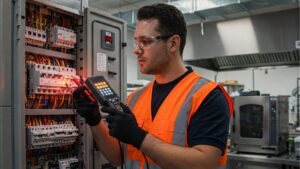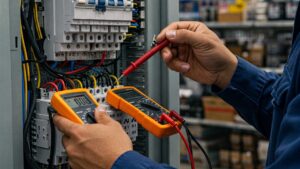Diagnosing electrical problems requires a systematic approach combining technical knowledge, specialized tools, and practical experience. Whether in residential, commercial, or industrial settings, properly electrical troubleshooting prevents safety hazards, reduces downtime, and ensures optimal system performance. This guide explores professional techniques for electrical troubleshooting, covering common issues, testing methods, and when to call expert electricians like those at Lightspeed Electricals.

Understanding the Process of Electrical Troubleshooting
Professional diagnosing electrical problems begins with gathering information about the symptoms and circumstances surrounding the electrical fault. An experienced electrician will interview occupants or maintenance staff to understand when the issue first appeared, what conditions trigger it, and whether any recent changes occurred to the electrical system. This preliminary step in electrical troubleshooting helps narrow down potential causes before physical inspection begins.
Visual inspection forms the next critical phase in diagnosing electrical problems. Electricians examine electrical panels, wiring, connections, and devices for obvious signs of damage, overheating, or improper installation. When Electrician Working on complex systems, this inspection may include thermal imaging to detect hot spots invisible to the naked eye.
Testing procedures vary depending on the nature of the problem when electrical troubleshooting. Basic voltage and continuity checks help identify open circuits, short circuits, or ground faults. More advanced diagnostics may require insulation resistance testing, earth leakage detection, or harmonic analysis for comprehensive system evaluation.
Common Residential Electrical Problems and Diagnosis
Homeowners frequently encounter electrical issues that require professional diagnosing electrical problems. Tripping circuit breakers represent one of the most common complaints, which could indicate circuit overloads, short circuits, or ground faults. Properly electrical troubleshooting behind breaker trips involves isolating circuits and methodically testing each segment.
Flickering lights often prompt calls for electrical troubleshooting. This symptom might stem from loose connections, voltage fluctuations, or failing light fixtures. An electrician Wiring In new circuits would check junction boxes and terminations while investigating such issues.
Dead outlets require careful diagnosing electrical problems to determine whether the issue lies in the outlet itself, upstream wiring, or the circuit breaker. Electricians use outlet testers and multimeters to trace the fault through the circuit systematically.
Commercial Electrical System Diagnostics
Diagnosing electrical problems in commercial environments presents unique challenges due to larger systems and higher voltages. Office Electrician Sydney professionals often troubleshoot issues involving three-phase power distribution, where problems may affect multiple circuits or equipment.
Voltage drop issues frequently require electrical troubleshooting in commercial settings. Long cable runs and heavy loads can cause significant voltage drops that affect equipment performance. Professional diagnosis involves measuring voltage at different points in the circuit under load conditions.
Grounding and bonding problems in commercial buildings demand thorough electrical troubleshooting to ensure safety and prevent equipment damage. Electricians use specialized earth resistance testers to evaluate grounding system effectiveness, particularly important when integrating Commercial Data Cabling with power systems.
Industrial Electrical Fault Finding
Diagnosing electrical problems in industrial facilities requires specialized knowledge of motors, control systems, and high-power distribution. Industrial Electrician Services professionals use advanced techniques like motor current analysis to identify winding faults or bearing problems before they cause failures.
Control circuit troubleshooting forms a significant part of diagnosing electrical problems in manufacturing environments. Electricians must understand ladder logic and schematic diagrams to trace faults through complex automation systems. This specialized skill set differs from standard Commercial Electrician Services requirements.
Power quality issues frequently require diagnosing electrical problems in industrial settings. Harmonic distortion, voltage sags, and transients can disrupt sensitive equipment. Sophisticated power analyzers help identify these intermittent problems that standard meters might miss.
Diagnostic Tools for Electrical Problems
Modern diagnosing electrical problems relies on various specialized tools. Digital multimeters remain essential for basic voltage, current, and resistance measurements. Advanced models include features like min/max recording and temperature measurement that aid in intermittent fault detection.
Insulation resistance testers (meggers) are crucial for electrical troubleshooting involving wiring degradation or moisture intrusion. These devices apply high voltage to test insulation integrity without damaging healthy systems.
Circuit tracers help when diagnosing electrical problems in complex wiring systems by identifying specific circuits behind walls or in crowded panels. This prevents unnecessary disruption during troubleshooting.
Thermal imaging cameras have become invaluable for electrical troubleshooting by revealing hot spots in panels, connections, and equipment before they cause failures. This non-contact method allows quick scanning of large areas.

Safety Considerations During Electrical Diagnostics
Safety remains paramount when diagnosing electrical problems. Qualified electricians follow lockout/tagout procedures to ensure systems are de-energized before working on them. When live testing is necessary, they use appropriate personal protective equipment (PPE) rated for the voltage levels involved.
Proper tool selection is critical for safe electrical troubleshooting. Insulated tools, voltage-rated gloves, and arc-flash protection may be required depending on the situation. Never attempt diagnosing electrical problems beyond your skill level or without proper equipment.
Work environment assessment forms part of professional electrical troubleshooting. Wet locations, confined spaces, or hazardous atmospheres require additional precautions to ensure safe troubleshooting procedures.
Systematic Approaches to Diagnosing Electrical Problems
Experienced electricians follow methodical processes when electrical troubleshooting. The divide-and-conquer approach involves systematically isolating sections of a circuit to narrow down the fault location. This prevents unnecessary testing and speeds up resolution.
Sequence of operation analysis helps when diagnosing electrical problems in complex systems. Understanding how components should interact makes it easier to identify where the actual performance deviates from expected behavior.
Historical data review can assist in electrical troubleshooting that develop over time. Maintenance records may reveal patterns or recurring issues that point to underlying causes rather than surface symptoms.
When to Call Professionals for Electrical Diagnostics
While homeowners can address some basic electrical issues, many situations require professional diagnosing electrical problems. Recurring circuit breaker trips, burning smells, or visible damage to wiring all indicate needs for expert assessment. Similarly, any problem involving the main service panel should be handled by licensed electricians.
Businesses should engage professional services for electrical troubleshooting affecting operations or safety systems. Lightspeed Electricals offers comprehensive diagnostic services for commercial clients experiencing electrical issues impacting productivity.
Industrial facilities particularly benefit from professional diagnosing electrical problems to prevent costly downtime. Specialized equipment and high-voltage systems require trained technicians with proper test equipment and safety knowledge.
Preventing Electrical Problems Through Proactive Measures
While diagnosing electrical problems is essential when issues arise, proactive maintenance reduces failure likelihood. Regular inspections by qualified electricians can identify potential problems before they cause disruptions. This includes checking connections, testing protective devices, and verifying equipment condition.
Load monitoring helps avoid many common electrical problems by ensuring circuits aren’t overloaded. Professional assessment of electrical demand versus capacity can prevent overheating and premature component failure.
Upgrading aging infrastructure prevents numerous electrical problems in older buildings. Rewiring outdated systems or replacing obsolete panels improves safety and reliability while meeting current code requirements.
Emerging Technologies in Electrical Diagnostics
The field of diagnosing electrical problems continues evolving with new technologies. Wireless monitoring systems now provide real-time data on electrical parameters, helping identify developing issues before they cause failures.
Advanced analytics software assists in electrical troubleshooting by identifying patterns in power quality data that human technicians might miss. These systems can predict equipment failures and recommend preventive actions.
Augmented reality tools are beginning to aid in diagnosing electrical problems by overlaying schematic diagrams onto physical equipment during troubleshooting. This helps technicians visualize complex systems and trace circuits more efficiently.

Conclusion: The Value of Professional Electrical Diagnostics
Properly diagnosing electrical problems requires a combination of technical knowledge, practical experience, and the right tools. While some basic troubleshooting can be performed by knowledgeable individuals, complex or dangerous situations demand professional expertise. From residential circuits to industrial power systems, accurate diagnosis ensures safe, effective repairs that restore full functionality.
Investing in professional electrical troubleshooting services saves money long-term by preventing misdiagnosis, unnecessary replacements, and potential safety hazards. Whether addressing immediate issues or implementing preventive maintenance programs, qualified electricians provide the expertise needed to keep electrical systems operating reliably. For comprehensive electrical diagnostics and repair services, trust experienced professionals to accurately identify and resolve your electrical problems.


